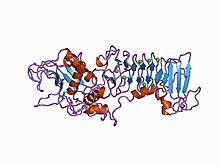Metalloproteinase
| Peptidase_M48 | |||||||||
|---|---|---|---|---|---|---|---|---|---|
 | |||||||||
| Identifiers | |||||||||
| Symbol | Peptidase_M48 | ||||||||
| Pfam | PF01435 | ||||||||
| Pfamclan | CL0126 | ||||||||
| InterPro | IPR001915 | ||||||||
| MEROPS | M48 | ||||||||
| OPM superfamily | 394 | ||||||||
| OPM protein | 4aw6 | ||||||||
| Membranome | 317 | ||||||||
| |||||||||
| Peptidase_M50 | |||||||||
|---|---|---|---|---|---|---|---|---|---|
| Identifiers | |||||||||
| Symbol | Peptidase_M50 | ||||||||
| Pfam | PF02163 | ||||||||
| Pfamclan | CL0126 | ||||||||
| InterPro | IPR008915 | ||||||||
| MEROPS | M50 | ||||||||
| OPM superfamily | 184 | ||||||||
| OPM protein | 3b4r | ||||||||
| |||||||||
Ametalloproteinase,ormetalloprotease,is anyproteaseenzymewhosecatalyticmechanism involves ametal.An example isADAM12which plays a significant role in the fusion of muscle cells during embryo development, in a process known asmyogenesis.
Most metalloproteases requirezinc,but some usecobalt.The metalionis coordinated to theproteinvia threeligands.The ligands coordinating the metal ion can vary withhistidine,glutamate,aspartate,lysine,andarginine.[clarification needed]The fourth coordination position is taken up by alabilewater molecule.
Treatment withchelating agentssuch asEDTAleads to complete inactivation. EDTA is ametal chelatorthat removes zinc, which is essential for activity. They are also inhibited by the chelatororthophenanthroline.
Classification
[edit]There are two subgroups of metalloproteinases:
- Exopeptidases,metalloexopeptidases(EC number:3.4.17).
- Endopeptidases,metalloendopeptidases(3.4.24). Well known metalloendopeptidases includeADAM proteinsandmatrix metalloproteinases,and M16 metalloproteinases such as Insulin Degrading Enzyme and Presequence Protease[1][2]
In theMEROPS databasepeptidase families are grouped by their catalytic type, the first character representing the catalytic type: A, aspartic; C,cysteine;G, glutamic acid; M, metallo; S,serine;T,threonine;and U, unknown. The serine, threonine and cysteine peptidases utilise theamino acidas anucleophileand form an acylintermediate- these peptidases can also readily act astransferases.In the case of aspartic, glutamic and metallopeptidases, the nucleophile is an activatedwatermolecule.In many instances, the structuralprotein foldthat characterises the clan or family may have lost its catalytic activity, yet retained its function inproteinrecognition andbinding.
Metalloproteases are the most diverse of the four main protease types, with more than 50 families classified to date. In these enzymes, adivalentcation,usually zinc, activates the water molecule. The metalionis held in place byamino acidligands, usually three in number. The known metalligandsare histidine, glutamate, aspartate or lysine and at least one other residue is required for catalysis, which may play an electrophilic role. Of the known metalloproteases, around half contain an HEXXH motif, which has been shown in crystallographic studies to form part of the metal-binding site.[3]The HEXXHmotifis relatively common, but can be more stringently defined for metalloproteases as 'abXHEbbHbc', where 'a' is most oftenvalineor threonine and forms part of the S1' subsite inthermolysinandneprilysin,'b' is an uncharged residue, and 'c' ahydrophobicresidue.[4]Prolineis never found in this site, possibly because it would break thehelicalstructureadopted by thismotifin metalloproteases.[3]
Metallopeptidases from family M48 areintegral membrane proteinsassociated with theendoplasmic reticulumand Golgi, binding onezincion per subunit. Theseendopeptidasesinclude CAAX prenylprotease1, which proteolytically removes the C-terminalthree residuesoffarnesylatedproteins.[citation needed]
Metalloproteinase inhibitors are found in numerous marine organisms, including fish, cephalopods, mollusks, algae and bacteria.[5]
Members of the M50 metallopeptidase family include:mammaliansterol-regulatory element binding protein (SREBP) site 2 protease andEscherichia coliprotease EcfE, stage IVsporulationprotein FB.
See also
[edit]References
[edit]- ^Shen, Yuequan; Joachimiak, Andrzej; Rosner, Marsha Rich; Tang, Wei-Jen (2006-10-19)."Structures of human insulin-degrading enzyme reveal a new substrate recognition mechanism".Nature.443(7113): 870–874.Bibcode:2006Natur.443..870S.doi:10.1038/nature05143.ISSN1476-4687.PMC3366509.PMID17051221.
- ^King, John V.; Liang, Wenguang G.; Scherpelz, Kathryn P.; Schilling, Alexander B.; Meredith, Stephen C.; Tang, Wei-Jen (2014-07-08)."Molecular basis of substrate recognition and degradation by human presequence protease".Structure.22(7): 996–1007.doi:10.1016/j.str.2014.05.003.ISSN1878-4186.PMC4128088.PMID24931469.
- ^abRawlings ND, Barrett AJ (1995). "Evolutionary families of metallopeptidases".Proteolytic Enzymes: Aspartic and Metallo Peptidases.Methods in Enzymology. Vol. 248. pp. 183–228.doi:10.1016/0076-6879(95)48015-3.ISBN978-0-12-182149-4.PMID7674922.
- ^Minde DP, Maurice MM, Rüdiger SG (2012)."Determining biophysical protein stability in lysates by a fast proteolysis assay, FASTpp".PLOS ONE.7(10): e46147.Bibcode:2012PLoSO...746147M.doi:10.1371/journal.pone.0046147.PMC3463568.PMID23056252.
- ^Thomas NV, Kim SK (2010)."Metalloproteinase inhibitors: status and scope from marine organisms".Biochemistry Research International.2010:845975.doi:10.1155/2010/845975.PMC3004377.PMID21197102.
External links
[edit]- TheMEROPSonline database for peptidases and their inhibitors:Metallo PeptidasesArchived2017-04-04 at theWayback Machine
- Metalloproteasesat the U.S. National Library of MedicineMedical Subject Headings(MeSH)
- Proteopedia:Metalloproteases
